Mentha spp.
With its sweet fragrance, sparkling flavor, and pretty flowers, mint makes a delightful addition to any garden.
It’s a welcome ingredient in cold beverages and teas, as well as in sweet and savory dishes. And its renowned taste and aroma are found in a myriad of products around the home from air fresheners to mouthwash.
Bees and other pollinators flock to the enchanting spires and tufts of flowers that bloom in pastel shades of blue, mauve, pink, or white. And this frost-hardy perennial even grows year-round in regions with warm winters.
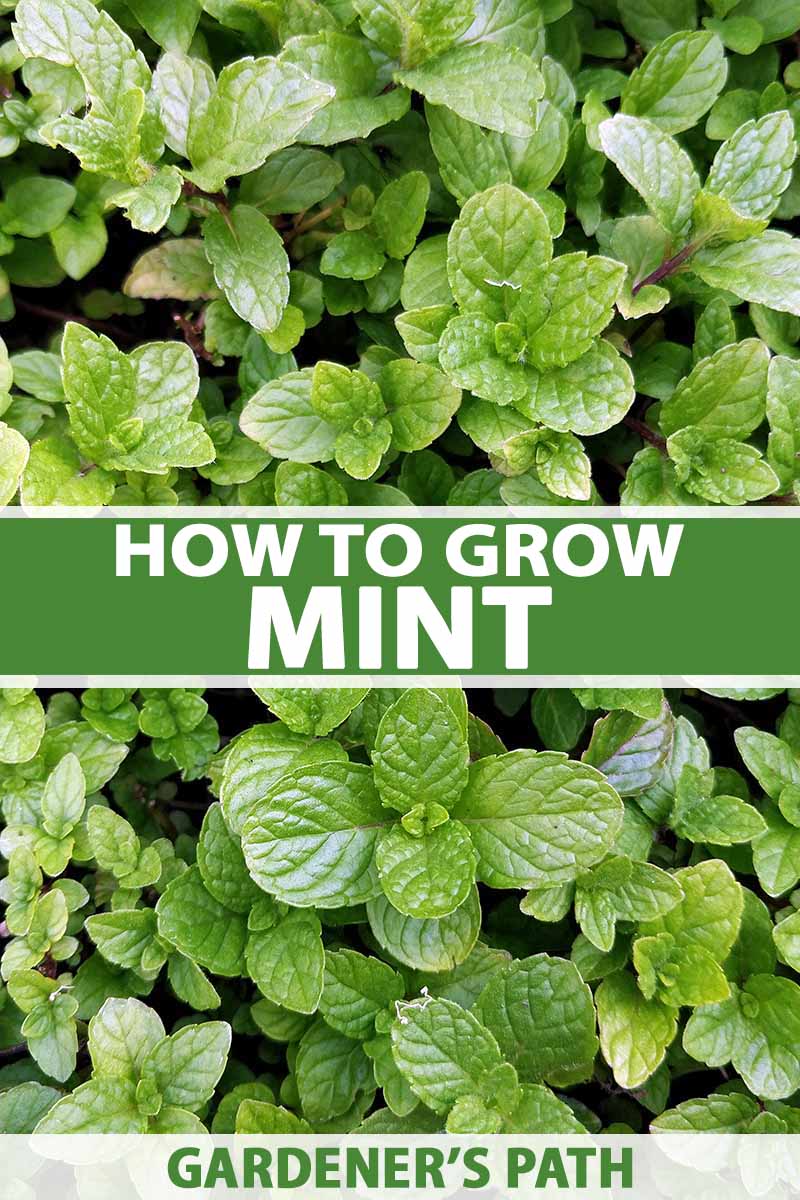
We link to vendors to help you find relevant products. If you buy from one of our links, we may earn a commission.
Now, you may have heard of mint’s legendary spreading properties.
And that you should avoid planting it in the garden to prevent it from “taking over.”
But that doesn’t mean you can’t enjoy growing this lovely herb. This just means it’s vigorous and easy to grow.
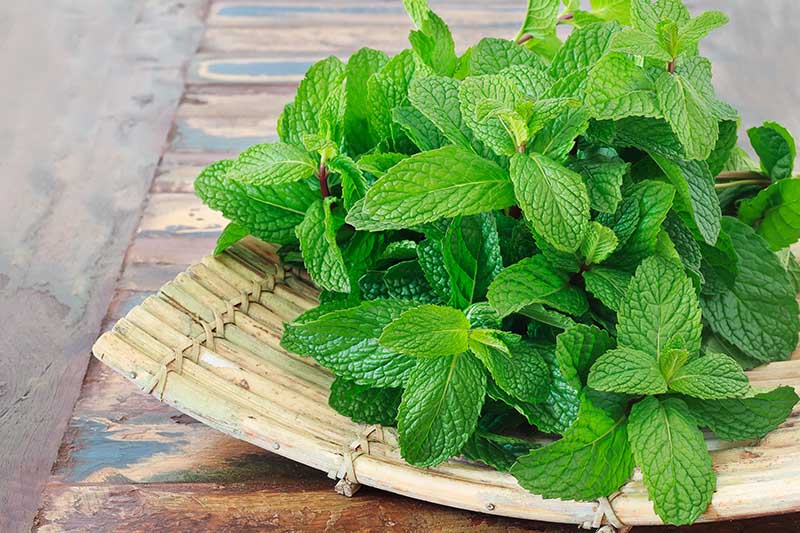
This lush, rewarding herb can be successfully cultivated in containers and garden beds to stop it spreading – and you’ll love the fresh-flavored results!
Here’s everything you need to know about how to grow mint.
What You’ll Learn
What Is Mint?
Mint is a highly aromatic, perennial herb in the genus Mentha of the Lamiaceae family.
The genus contains approximately 20 species and numerous natural hybrids.
Peppermint, M. x piperita, is one such hybrid, a cross of M. aquatica and M. spicata.
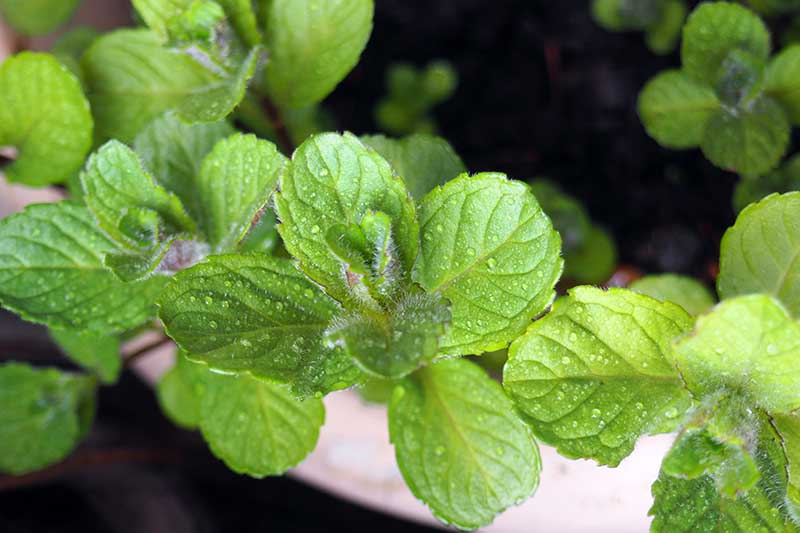
In their natural environment, plants thrive along marsh edges, in meadows, along stream banks, and woodland fringes – growing 12 to 36 inches tall at maturity.
Most species are native to temperate regions of Africa, Asia, or Europe, with a few indigenous to Australia (M. australis), and North America (M. arvensis and M. canadensis).
The presence of pungent essential oils gives Mentha its attractive fragrance that fills the surrounding area with a sweet perfume.
Plants are easily identified by their bright scent and refreshing taste, and by the square stems typical of Lamiaceae family members.
Tiny blooms in terminal racemes form flowering spires on tall spikes, and smaller flower tufts often form in the leaf axis. Blooms appear from mid to late summer, and are highly attractive to bees, butterflies, and other pollinators.
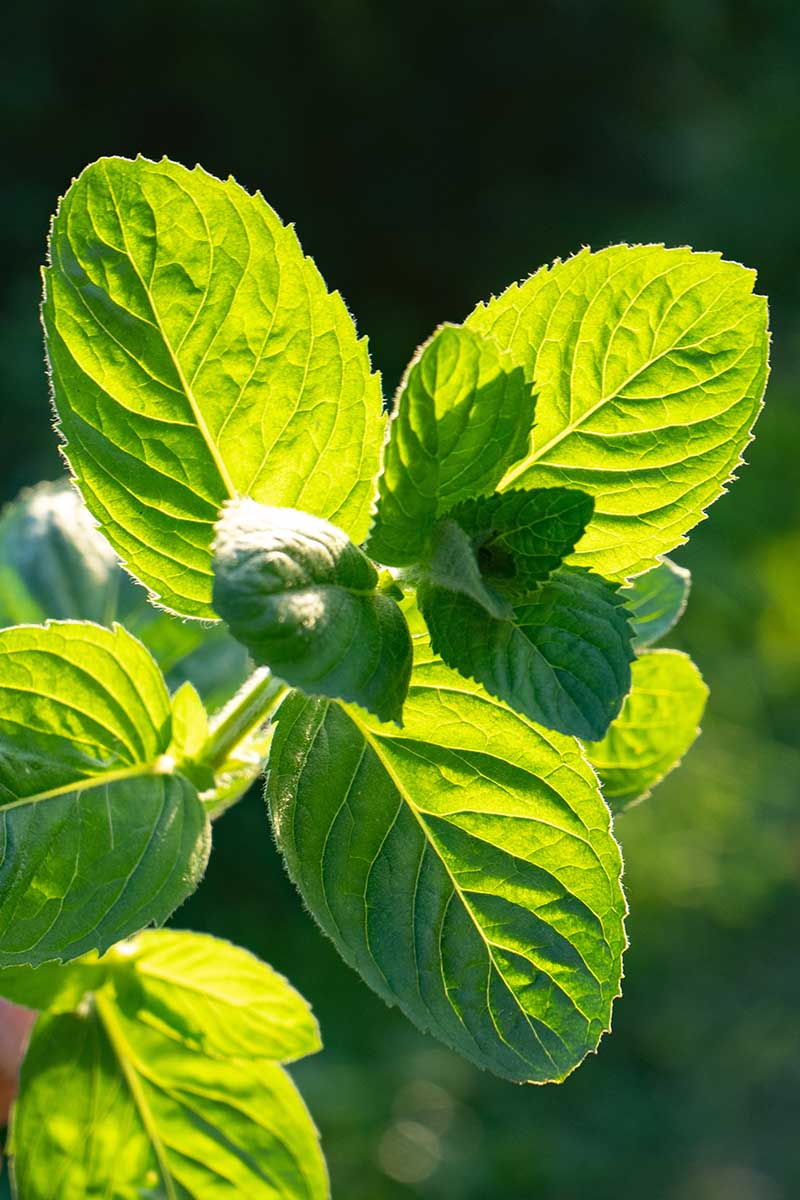
Leaves have a serrated edge and can have either a smooth or fuzzy texture. They come in all shades of green – with some variegated types as well.
Fast growing, plants send out runners (stolons) above and below ground to quickly establish large, lush colonies.
For this reason, they need to be contained when planting, if you don’t want them to take over – or only planted in areas where you don’t mind them spreading freely.
Fragrant and deliciously cooling, mint is a popular beverage and kitchen herb. It’s also widely used in candies, teas, and toiletries – as well as aromatherapy and herbal remedies.
According to an article by Monica H. Carlsen, et al, published in the BMC Nutrition Journal, Mentha is high in antioxidants, and has long been recognized for its aromatic, medicinal, and therapeutic properties.
Cultivation and History
The name originates from a Greek myth about a river nymph and means “having a sweet smell.”
A versatile herb, it has been cultivated for cooking and medicinal use throughout history.
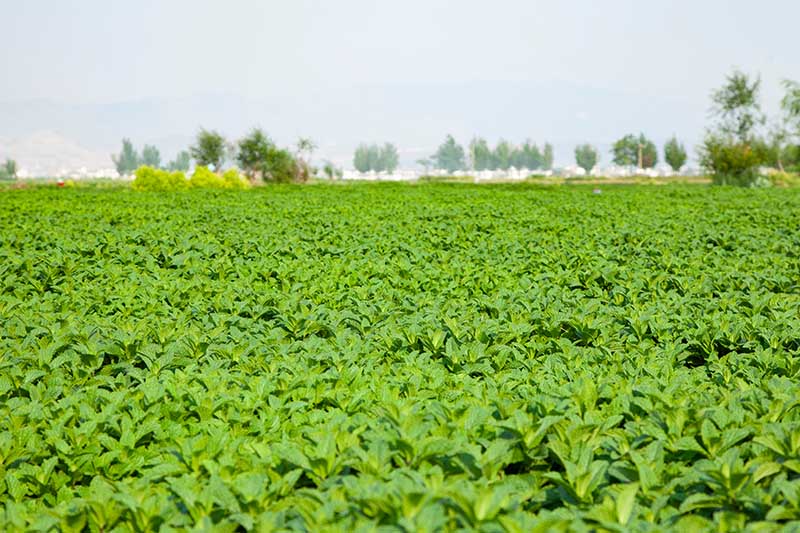
The ancient Egyptians used the oil to treat a variety of ailments. The first recorded documentation of medicinal oil use was published in the library at Alexandria in 410 AD.
The Roman historian Pliny the Elder reported many uses including scenting bathwater and perfumes as well as flavoring beverages, sauces, and wine.
By medieval times, Mentha was commonly grown in gardens for kitchen and apothecary use.
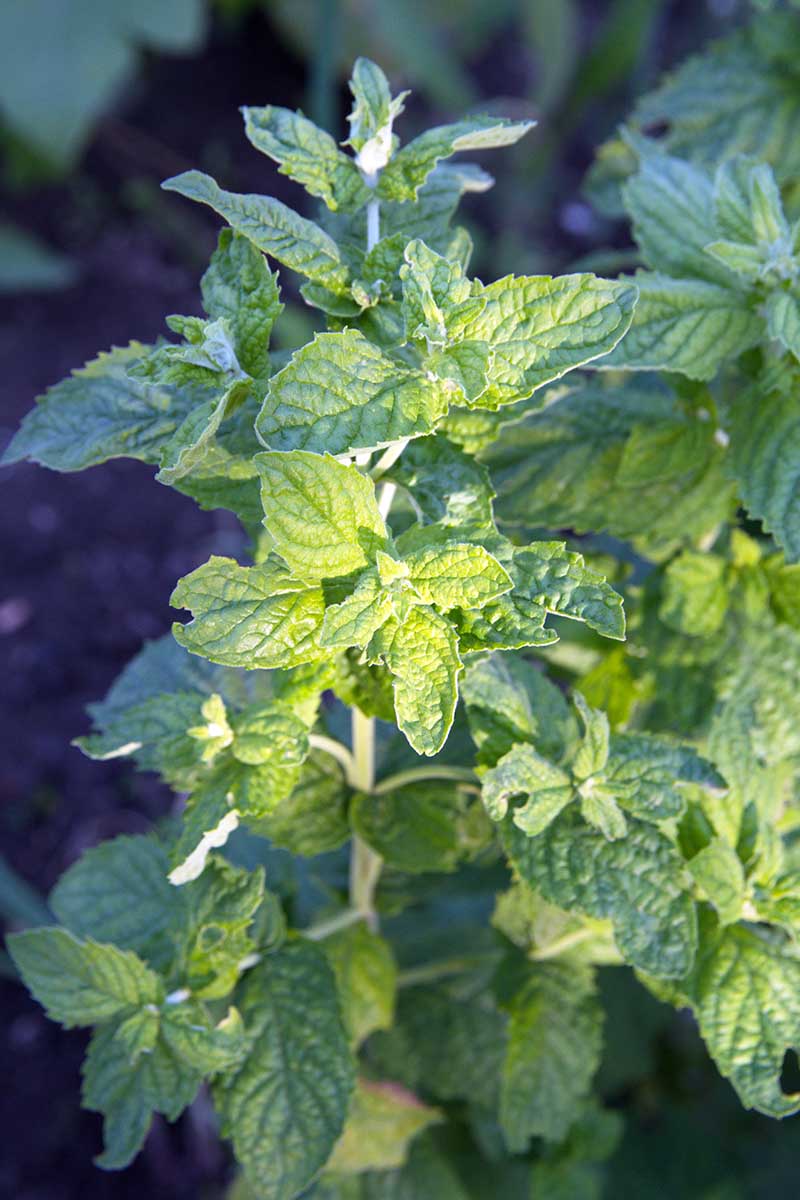
And in the mid-1700s, commercial cultivation for the essential oil was established in England, with the Netherlands, France, and Germany following soon after.
For centuries, all plant parts – flowers, leaves, roots, and stems – have been used in folk medicine to treat a number of health issues, including gastrointestinal distress and respiratory illnesses.
A tea made of dried leaves is sometimes consumed to relieve a sore throat.
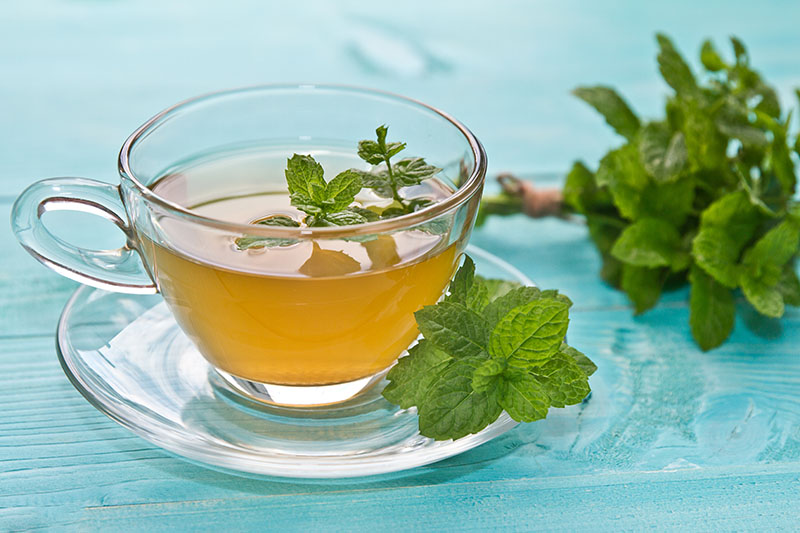
Although mint grows wild in North America, root stock was introduced by English settlers, and by the 1790s crops for distillation of the essential oil were commercially grown in Massachusetts.
Today, Mentha is an important commercial crop in Washington, Oregon, and Idaho with the oils used primarily to flavor candy, chewing gum, cough drops, mouthwash, and toothpaste.
Mint Plant Propagation
Mentha seed is tiny – at approximately 14,000 seeds per gram – and difficult to germinate.
And, being an avid cross breeder, seeds produce variable results – often with a different taste and appearance than that of the parent plants.
I have an unintentional patch of minty oregano from this cross-pollination trait – it’s very tasty in icy drinks!
Commercial growers propagate vegetatively, and root division or stem cuttings give the best results for home gardeners.
If you want to try growing it from seed, we have more tips here.
By Root Division
Autumn is the ideal time to take root cuttings, but early spring works as well.
Choose a rootbound container plant and gently remove the root ball from the pot. Using a hand saw or garden shears, cut the root ball into quarters.
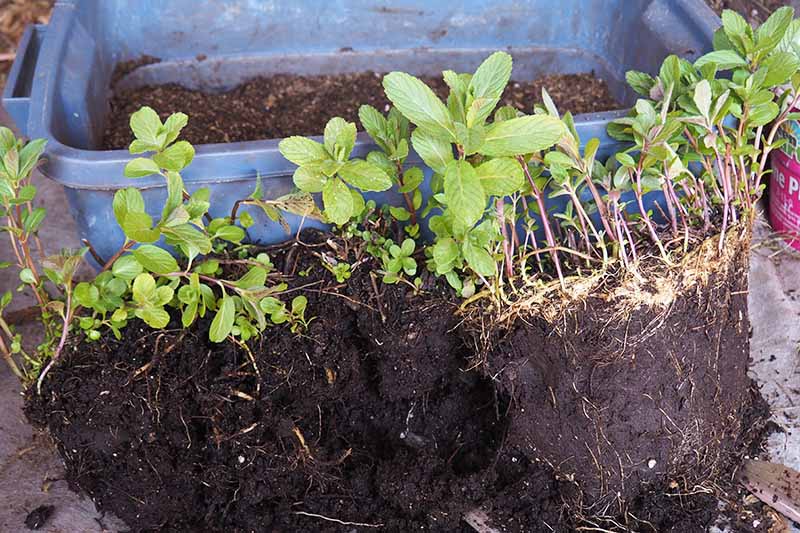
Fill small two- to four-inch pots or trays with a soil mix of one part well-aged compost, one part vermiculite or peat moss, and one part landscape sand. Water well until the soil mix is evenly moist.
Repot two or three of the divisions in fresh soil and divide the remaining quarter to create several smaller root cuttings, each with at least one stem.
Trim off the top growth and prune the hairy roots to fit in your containers.
Set the cuttings in place then top up with soil and firm gently.
Water lightly then set out in a cold frame or a protected site with bright, indirect light and steady moisture.
By Stem Cutting
Choose strong stems with fresh, healthy green leaves.
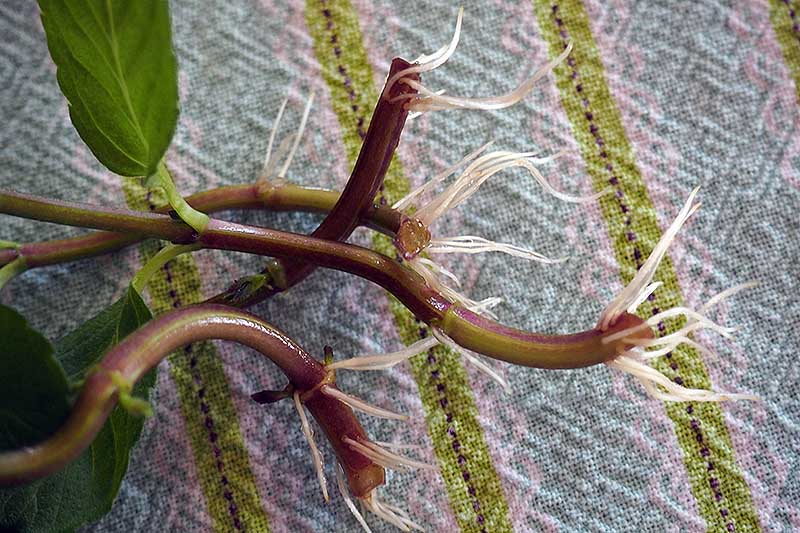
Cut off four- to six-inch pieces, removing the lower three or four sets of leaves. Cut the stem just below a set of leaf nodes to prevent it from curling in water.
Longer stems are preferable because roots sprout from the leaf nodes – more leaf nodes from long stems means more roots and a strong plant.
Place stems in a small glass of water, and set in a light, airy windowsill until healthy roots have formed.
The roots will start to form in 10 to 14 days and cuttings can be planted out in three to four weeks.
Once a strong root system has formed, pot up the stems into containers six to eight inches deep and wide, filled with sterile, well-draining potting soil.
Firm the soil around the stems and water gently.
Keep the pots in a sheltered spot for four to six weeks, ensuring the soil stays moist but not waterlogged. After plants are established, transplant into the garden in their permanent locations.
How to Grow Mint Plants
Mint is a vigorous grower that likes organically-rich, well-draining soil with a slightly acidic to neutral pH of 6.0 to 7.0. Plants are hardy in USDA Hardiness Zones 3 to 8.
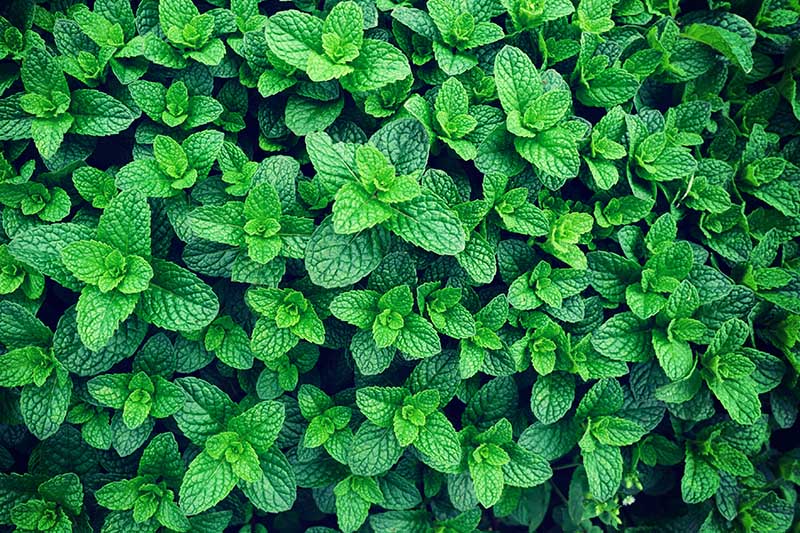
These plants prefer full to partial sun exposure and variegated types may need shade protection from the hot afternoon sun.
Plant out in spring after the last frost, or in late summer once the evenings start to cool.
Keep soil consistently moist and water when the top inch of soil becomes dry.
Once new growth emerges in spring, feed with an all-purpose, water-soluble plant food, such as 10-10-10 (NPK). Fertilize once more midway through the growing season if needed.
After plants are established, harvest leaves regularly by pinching out the tops. New leaves are more flavorful and tender than the older ones, and pinching promotes bushy growth.
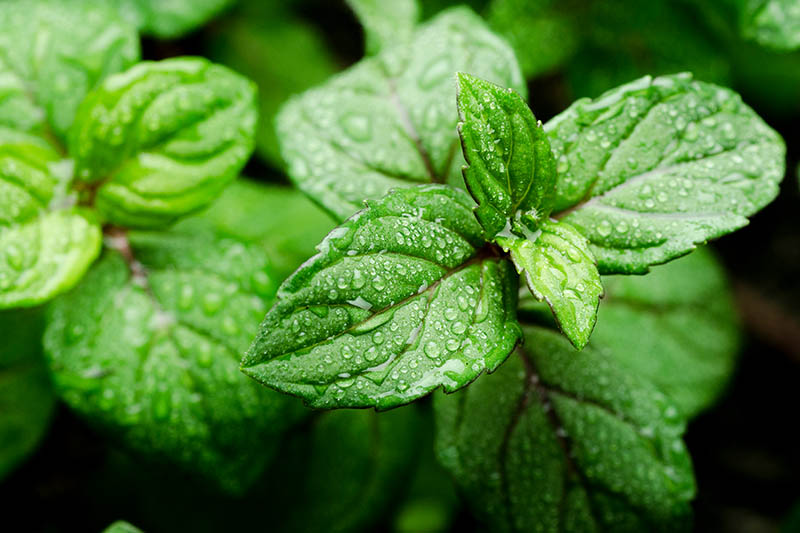
In the garden, space plants 12 to 24 inches apart in containers to keep growth in check. Use large containers measuring eight to 24 inches in diameter and with a similar depth.
Sink the containers into garden beds, leaving the top two inches of the rim above ground. This helps to prevent runners from escaping into fertile soil and establishing new plants.
Improve the soil with equal parts aged compost or other rich organic matter and landscape sand to improve drainage.
Ensure pots have plenty of material covering the drainage holes such as coconut coir, pebbles, or broken pottery to prevent the roots from sitting in water.
Turn pots in the ground every 14 to 28 days to stop the roots from spreading through the drainage holes.
Alternatively, plant directly into the ground in an area where you don’t mind it spreading.
Consider burying some metal flashing or landscape edging to sink eight inches deep around the plant to prevent it from taking over. Mint can make a useful ground cover and some varieties will tolerate a little foot traffic.
Mulch pots and in-ground plants with a two-inch layer of straw to retain moisture and keep weeds in check.
Mentha plants will tolerate a light frost, but the top growth will eventually die back in winter. In autumn, cut stems back to the ground and cover with a two-inch layer of mulch if your winters are harsh.
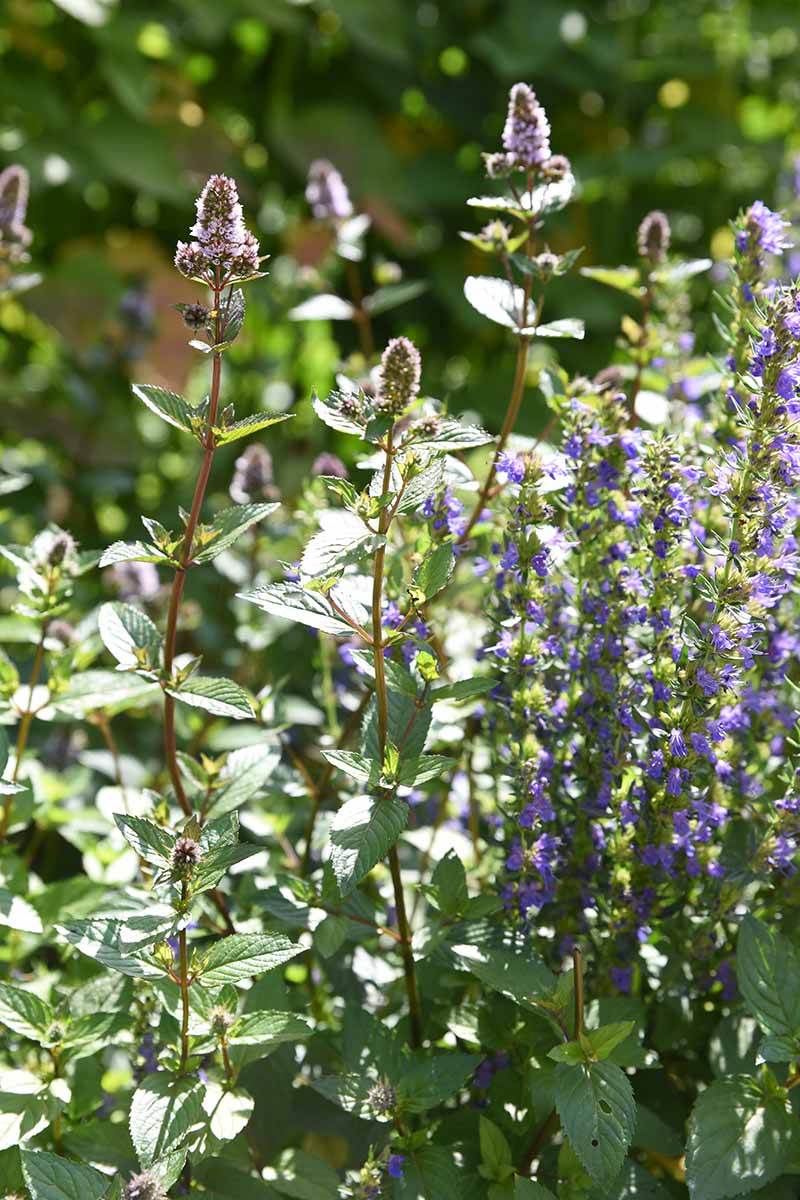
While humans are quite enamored of this herb, many animals and insects are not. It is known to repel ants, cockroaches, deer, mice, spiders, and squirrels, which makes it a useful companion plant for other crops.
In the garden, grow it near cabbages and tomatoes to deter cabbage moths.
Containers
Grow mint in containers of rich, well-draining soil amended with three parts soil to one part organic matter such as aged compost. You can add one part landscape sand to improve drainage if needed.
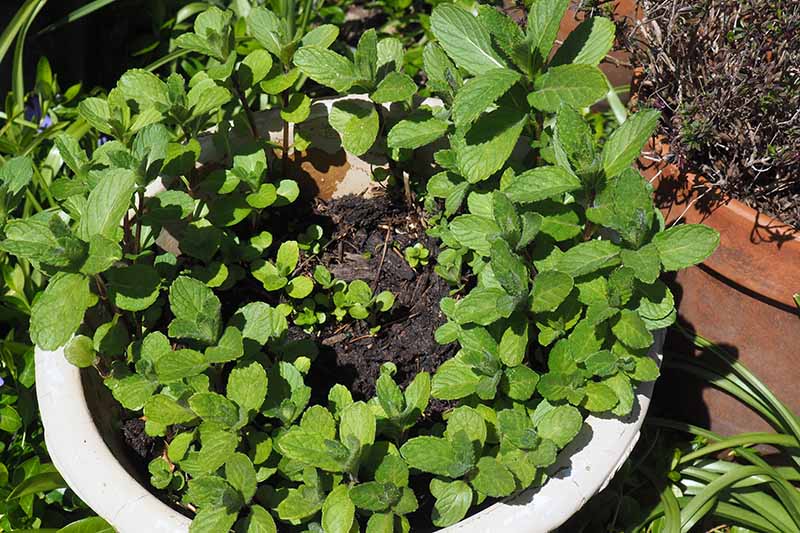
Ensure pots have plenty of drainage material – such as broken pottery, gravel, or pebbles – at the bottom and keep soil moist but not wet.
Fertilize with an all-purpose liquid plant food such as 10-10-10 (NPK) in spring and once more midway through the growing season.
For a steady harvest, give your containers some afternoon shade to prevent heat stress.
Container plants should be divided every three to four years to rejuvenate plants.
Growing Tips
Keep the following in mind for easy growth and an abundant crop:
- Don’t allow the soil to dry out, as these plants are moisture lovers
- Provide light shade in areas with hot afternoon sun
- Restrict plants from spreading by cultivating in containers or with landscape barriers
- Allow some plants to flower throughout the garden to attract pollinators
- Protect plants with a 2-inch layer of mulch to help retain moisture
Mint Cultivars to Select
Botanists disagree as to exactly how many species of this herb exist, with most landing in a range of 13 to 20 different types. Close to 2,000 different cultivars are available.
The most popular varieties for home cultivation include spearmint (M. spicata), peppermint (M. x piperita), wild mint (M. arvensis), and Scotchmint (M. x gracilis).
Peppermint
M. x piperita is one of the more well-known species and is a favorite for use in beverages, desserts, and sweets because of its strong menthol flavor.
This plant will grow 12 to 36 inches tall at maturity and, like most plants of this family, prefers a part sun location.
Seeds are available in a variety of package sizes from True Leaf Market.
You can also pick up a three-pack of plants at Burpee.
Read more about growing peppermint plants here.
Peppermint Chocolate
M. x piperita ‘Peppermint Chocolate’ is another popular type often seen in local nurseries – probably because of its name!
This variety has brown stems and the leaves have a chocolate-mint aroma and flavor, making it perfect for use in cold drinks and tea.
Three-packs of plants are available at Burpee.
Spearmint
M. spicata has long been popular with herbalists and in kitchen herb gardens and has less menthol, giving it a sweet, fresh taste.
It’s best suited for flavoring savory dishes, veggies, and teas.
You can pick up seeds by the packet or in bulk from Eden Brothers.
Read more about growing spearmint here.
Orange
M. x piperita f. citrata ‘Orange’ has a strong citrus scent and flavor that makes it popular in cold beverages, salads, teas, and with fruit or ice cream.
Find plants in three-packs at Burpee.
Pineapple
M. suaveolens ‘Pineapple’ is an attractive, variegated cultivar, typically with white margins on its leaves and a light, citrusy fragrance.
Pick up three-packs of variegated pineapple mint plants at Burpee.
Look for more options?
Be sure to check out our supplemental guide, “15 of the Best Mint Varieties to Grow at Home.”
Managing Pests and Disease
All species are considered deer, rabbit, and rodent resistant.
Mentha plants are typically low maintenance, but there are a few problems to watch for.
Insects
There are a couple of different insect pests that might like to munch on your mint.
Aphids
Aphids are small, soft-bodied insects that can cause damage by sucking sap and spreading fungal disease.
A strong jet of water from the garden hose quickly reduces aphid populations.
You can learn more about controlling aphids in your garden here.
Spider Mites
Spider mites can cause stunted and deformed growth. These can also be handled with a strong blast of water.
If insects become problematic, apply an insecticidal soap such as this one from Safer Brand, available through Home Depot.
Disease
If you do notice problems with your mint, it could be one of the following:
Anthracnose
Anthracnose is a fungal disease that can spread quickly in warm, wet weather, causing small spots that gradually get larger until the leaves drop off.
Remove diseased plants promptly to prevent its spread.
Keep plants off the ground and ensure good air circulation. The spores overwinter in plant debris, so clean beds well in fall and remember to rotate crops. Avoid splashing water onto lower leaves.
Mint Rust
Mint rust is another fungus that causes small brown, orange, or yellow pustules on undersides of leaves.
Infected plants should be removed to prevent this disease from spreading.
Heat treating the roots may help to control rust. To do this, immerse roots in hot water, heated to 111°F, for 10 minutes then cool under running water and plant as usual.
Powdery Mildew
Powdery mildew is another fungus that can also show up in moist, damp conditions, coating leaves and stems in a fuzzy dusting that weakens and damages plants.
Remove any infected plants and allow the soil to dry out. Thin plants if needed to improve air circulation and don’t water until the top inch of soil is dry.
Harvesting Mint Plants
The quality of the volatile oils that give mint its characteristic flavor are best during the long days of summer when plants receive 14 hours of daylight or more.
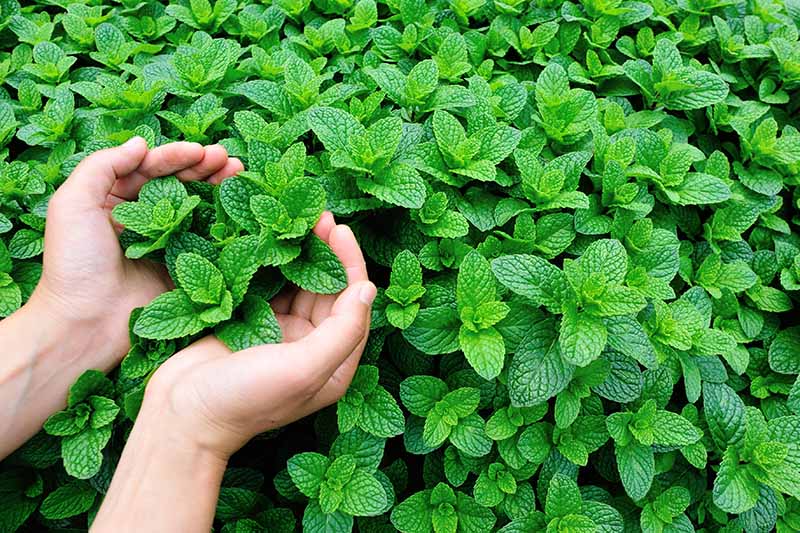
And for the best aroma and flavor, plants should be harvested before flowering.
Harvest on a sunny day by shearing the tops of the plants after the morning dew has dried. Cut stems to just above the first or second set of leaves.
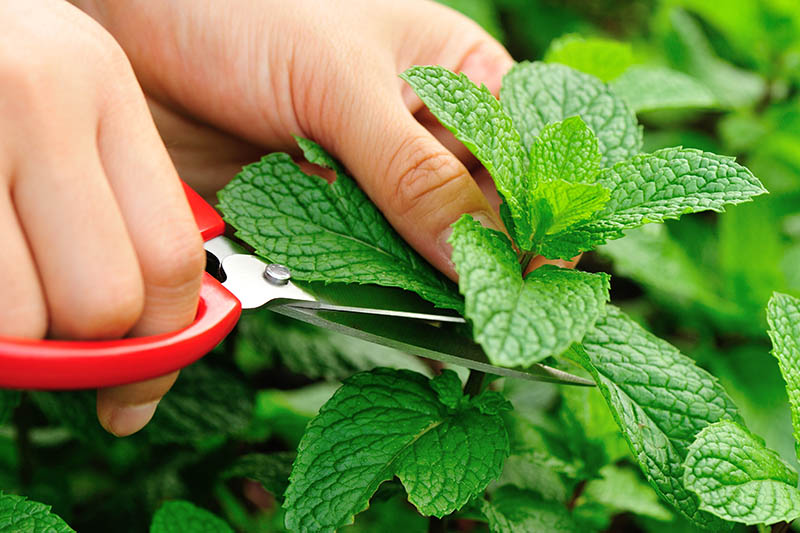
Plants can be harvested three or four times a year, or more frequently if you take just a few sprigs at a time, and frequent harvesting helps to keep them bushy.
Preservation
Like most herbs, mint is best enjoyed fresh. But it can be dried or frozen as well.
Fresh Storage
Sprigs will keep fresh in the fridge for up to seven days.
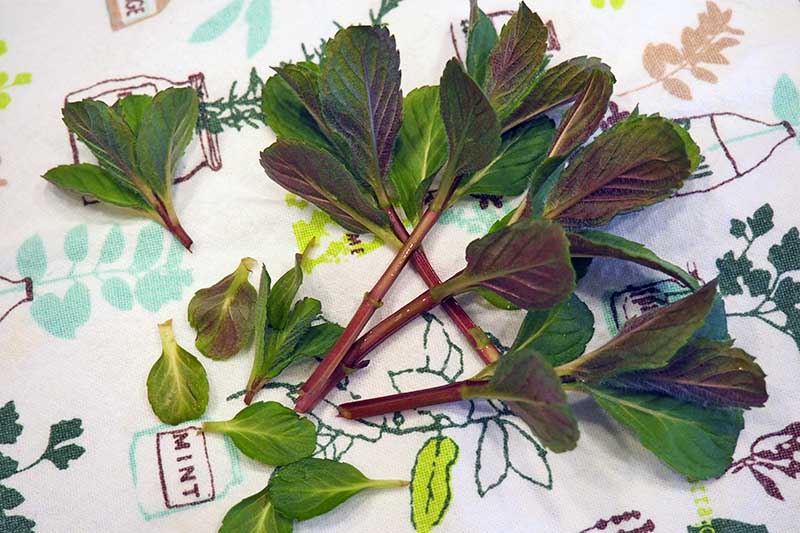
Rinse cuttings and lightly shake off excess water.
Gently wrap leaves in a damp paper towel and place the paper towel inside a loosely sealed plastic bag or storage container. Refrigerate.
Or, trim the stem ends and place them in a small glass of water. Place the glass in the fridge and cover loosely with a bag, replacing the water every three to four days.
Dried
Rinse your harvest under cold, running water and dry in a salad spinner or pat dry with a clean dish towel.
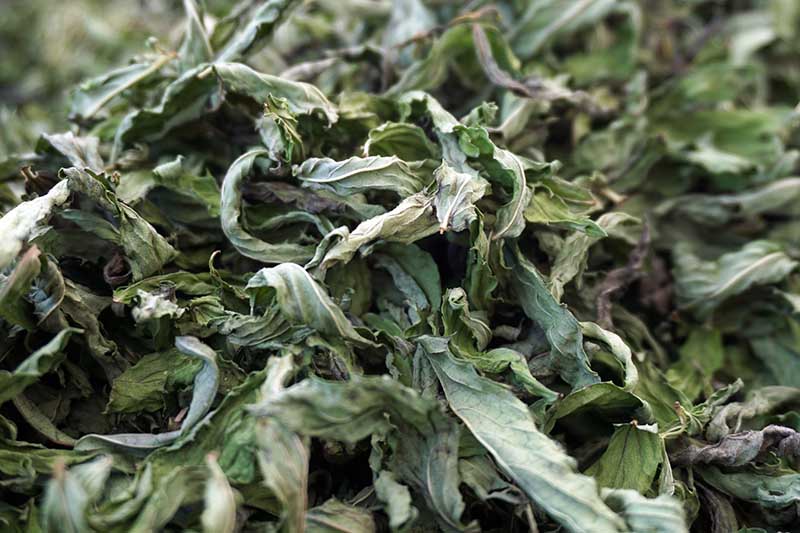
Tie several stems together into small bunches of 10 to 25 stems and hang upside down in paper bags. Choose a cool, dry location with ample air circulation.
When leaves are dry and crumbly, in one to two weeks, strip them from the stem and store in airtight containers in a cool, dark cupboard.
Or, use your dehydrator at the lowest setting to dry leaves removed from the stems.
Find more tips on drying herbs here.
Freezing
To freeze into cubes for iced tea or mojitos, rinse and pat dry cuttings.

Remove the leaves and discard the stems.
Chop leaves coarsely, adding about two teaspoons into each compartment of an ice cube tray.
Top with water and freeze.
Freshly squeezed lemon juice can be used to replace the water. A small wedge of lemon or lime or a pinch of zest can also add citrus flavor.
You can also pop in a few berries for a fruity twist, or add some fresh tarragon for a hint of licorice.
Once frozen, remove the cubes and store in an airtight container for up to three months.
Whole leaves can also be frozen for use in sauces, smoothies, soups, stews, and teas.
To do this, rinse and dry stems then strip off the leaves.
Place leaves in a single layer on a baking sheet and freeze for two to three hours.
After the leaves are frozen, remove them from the baking sheet and place in airtight containers in the freezer where they will last for up to three months.
Find more techniques for freezing fresh herbs here.
Recipes and Cooking Ideas
Fresh mint makes a lovely complement to fish, lamb, and poultry, and can spruce up lightly steamed veggies like baby carrots, peas, and new potatoes.
Leaves pair well with fruit and tossed salads, and mint is popular in Middle Eastern dishes like tabbouleh.
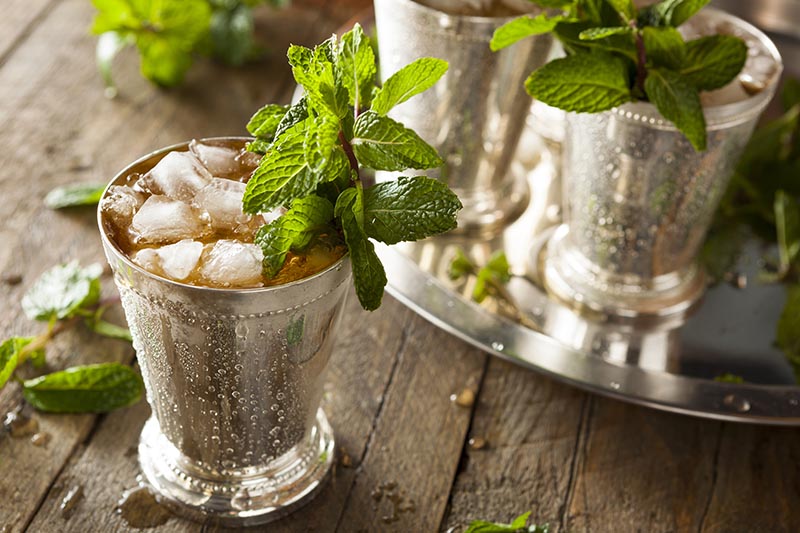
It’s flavor can enhance beverages such as lemonade, punch, and herbal teas. And a julep or mojito would be nowhere without the cooling zest of mint!
For cooking, bear in mind that peppermint’s flavor is mentholated. That means it’s cool and strong, making it well-suited for alcohol-based drinks, desserts, and sweets.

Spearmint has a lightly sweet flavor and is more commonly used in savory dishes.
To enjoy your crop, why not start off with a Tomatillo-Jito from our sister site Foodal? This refreshing beverage is a tart twist on a classic cocktail, made with fresh tomatillos.

Also from Foodal, you might enjoy spicy pork tacos with peach and corn salsa, where the herb adds a special pop to the flavorful salsa.
Other Garden Uses
Mints have lovely, soft flowers that are highly attractive to pollinators.
Allow a few pots to bloom and place them throughout the garden – they’ll repel unfriendly pests and attract beneficial insects.

In the right place, mint makes a pretty and fragrant seasonal ground cover. But remember, it’s a spreader and should only be planted where it won’t become invasive.
It loves moist areas and is a natural along stream banks, lightly shaded meadows, and the fringe areas around marshes and ponds.
The sweet, fresh fragrance can also be enjoyed between pathway pavers, where walking on it releases the scent.
But ensure the roots are restricted to the pathway with hardscape borders. If needed, use a landscape edging barrier for effective root management.

Landscape Edging Barrier via Amazon
This one from Amazon Basics gives malleable control and is available via Amazon.
Quick Reference Growing Guide
| Plant Type: | Perennial herb | Tolerance: | Light frost |
| Native to: | Temperate zones of Africa, Asia, Australia, Europe, and North America | Maintenance: | Low |
| Hardiness (USDA Zone): | 3-8 | Soil Type: | Rich and loamy |
| Season: | Spring and summer | Soil pH: | 6.0-7.0 |
| Exposure: | Full to partial sun | Soil Drainage: | Well-draining |
| Time to Maturity: | 90 days | Attracts: | Bees, butterflies, and other pollinators |
| Spacing: | 12-24 inches | Companion Planting: | Cabbages, peas, and tomatoes |
| Planting Depth: | 6 inches (root ball), lightly cover for seeds | Avoid Planting With: | Parsley and chamomile |
| Height: | 12-36 inches | Family: | Lamiaceae |
| Spread: | Vigorous | Genus: | Mentha |
| Water Needs: | Moderate to high | Species: | Aquatica, arvensis, australis, canadensis, spicata, x piperita |
| Common Pests: | Aphids, spider mites | Common Disease: | Anthracnose, rust, powdery mildew |
A Zesty Cool Herb
Planting zesty cool mint not only means adding an attractive plant to your landscape, but also a fantastic flavoring agent for drinks, savory dishes, and desserts.

Remember to provide plenty of supplemental water and prune or pinch regularly, and that’s about it. Oh, and don’t plant it in the ground unless you have a few acres you want quickly covered in this herb!
Have you ever grown mint? Did it take over your whole yard, or did you put it in a container? Tell us your minty tales in the comments below.
And if you’d like to learn about other easy-to-grow herbs, check out these guides next:
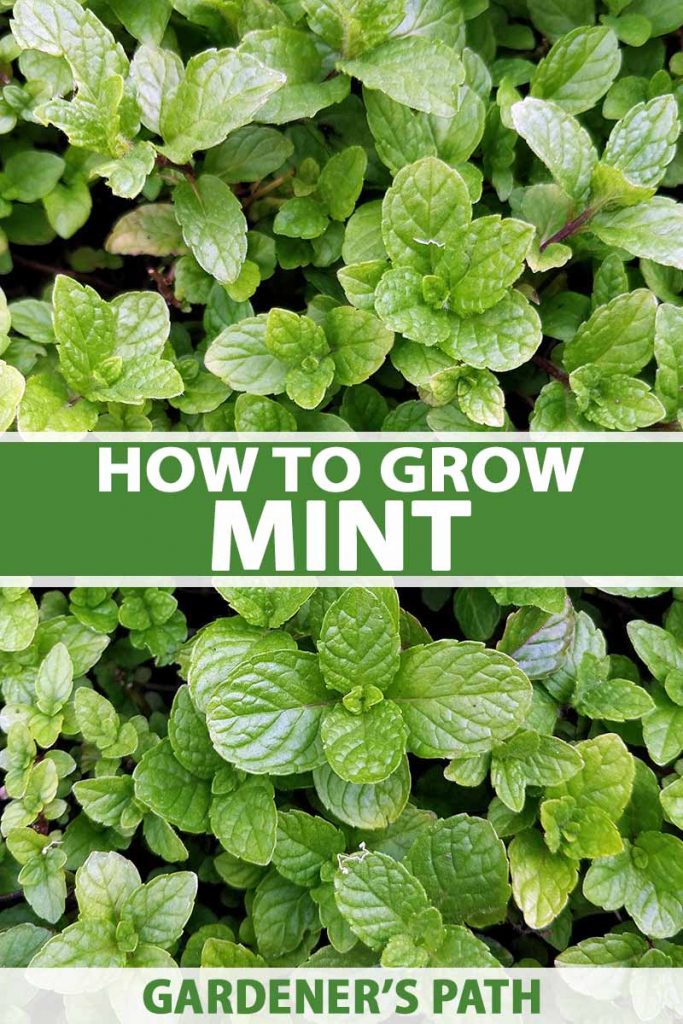
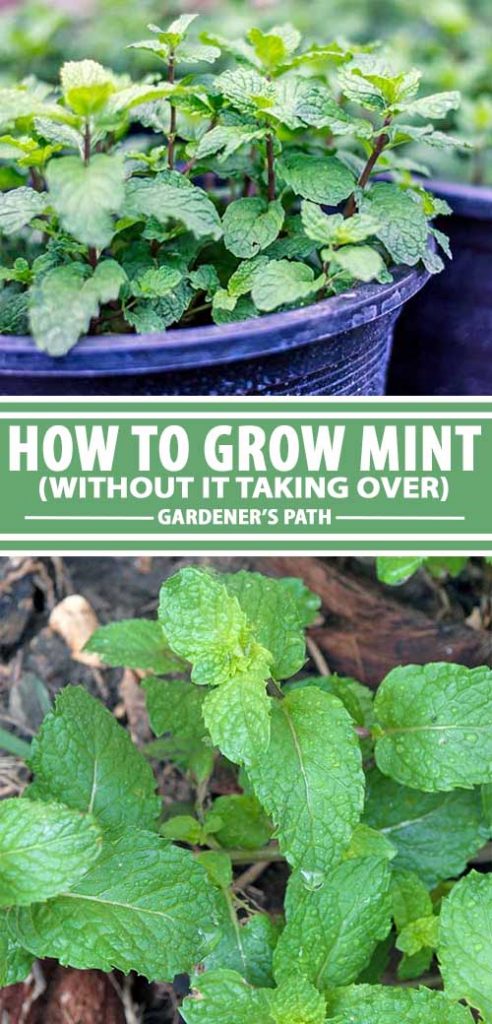
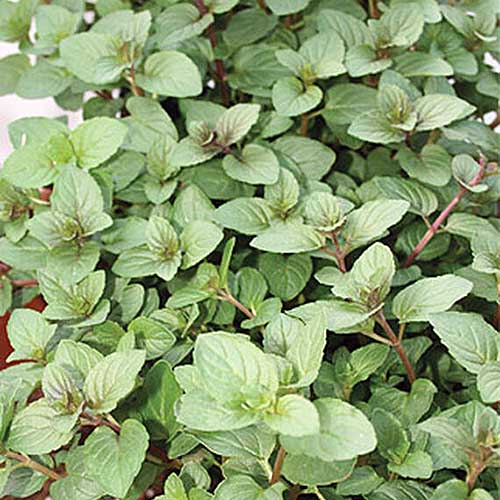
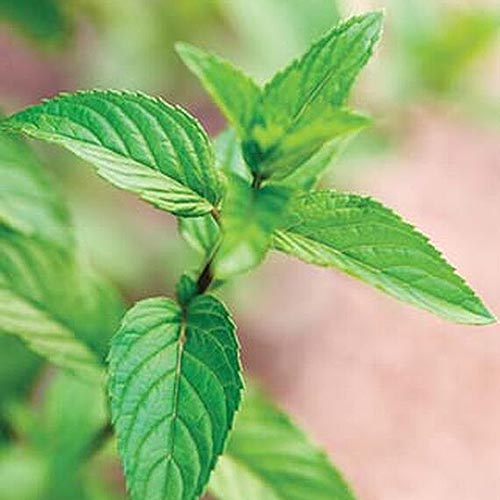
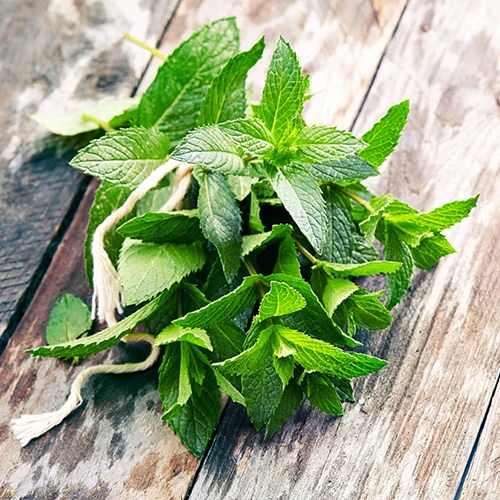


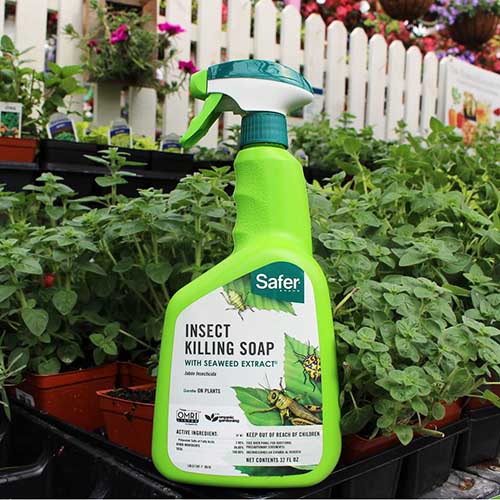
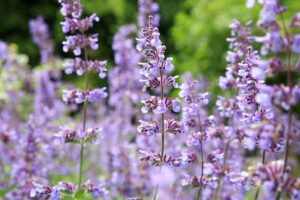


I just love the way mint smells so I planted mine in a pot. Often prune them for tea or just an aromatic brew.
Yes! I walked by some last night outside a restaurant. I brushed my hand along the tops of the plants and loved the aroma!
Mint is one of my favourite herbs – maybe the second one after basil! I love to add it to water with a lemon and also to some desserts, because it tastes so fresh. I have got mine since, I think, 2 years and it grows amazing! I decided to buy it on the Internet because my previous ones, that I have bought in shops, were withering easily. In my home, I have got an apple mint – it is the one that you mentioned. And yeah, as you said it is “a starter plant,” but for my requirements it… Read more »
Hi Kate! Yes! It adds such a wonderful flavor to so many drinks and dishes. I’m glad it has done well for you!
I got a few pieces from my dad a few years ago and now I have it completely around my house. Really enjoy the aroma as I walk around the outside and have many bags of dried mint squirreled away in the house and garage. I currently grow peppermint, spearmint and chocolate mint.
Oh, so you have a dad-mint connection, also! Love it! You’re growing a nice variety.
What happens when it starts flowering? Does it die, as basil does?
Nope; it won’t die. It just gets kinda leggy.
When the mint starts flowering should I cut the flowers
It’s not necessary; the plant won’t die if you leave the flowers. But you’ll get a bushier plant with more leaves if you cut the flowers.
Sounds like the best way to keep it contained is in big pots or containers. I’m just afraid they will dry out to fast in the heat of summer. I made the mistake of putting some in a raised garden and it took over. Thoughts?
Hi Tammy! Yes, the best way is to put them in a big pot, and yes, you have to be very diligent about daily watering. I usually start 2-3 pots of mint in the spring, and if I still have one in August, I’m lucky. Haha. It’s hard to remember to get out there and water all the time, what with work, kids, and life!
If I plant mint in a raised bed that is 10″ deep will it grow under the raised bed and escape?
That all depends, Jim. Is the raised bed 10 inches in height above the ground, or sunk 10 inches into the ground? Thought mint spreads laterally, it doesn’t have particularly deep roots. If your raised bed perimeter is sunk at least 5 inches below ground, this should suffice to contain it.
Hi
I have seen garter snake in my yard. Read peppermint plants keep them away. I want to plant mint plants but not sure if I should put it in the ground or pots?
I can understand the impulse, Mira! My grandmother was very opposed to having snakes in her yard, and did her best to eradicate them. However, keep in mind that garter snakes do serve a purpose, as a native, wild form of pest control – they like to eat mice and insects. As I understand it, peppermint is actually more of a deterrent for rodents than it is for snakes, and in my experience, it doesn’t always work. Some small rodents will happily venture into the garden even if mint is planted there. But giving it a try couldn’t hurt. Ensure… Read more »
I read that mint was a wasp repellent, is this true?
Mint plants (including peppermint, spearmint, and wintergreen) have been noted to repel some pests such as wasps, so this is true! But you might actually see the strongest effect as a natural repellent if you use apply something concentrated, like peppermint essential oil. Studies like this one have shown essential oils to be effective against yellowjackets and paper wasps.
Keep in mind that many types of wasps play a beneficial role in the garden, acting as pollinators, or parasitizing other types of insect pests. But the stinging varieties can certainly be a nuisance!
If I plant the mint plants around the house and my garden is approx 20 ft away, will my garden be safe? Also when planted around the house will it cause any damage to my lawn?
Mint can spread several inches per year if it’s thriving and has access to enough water, so the short answer is that your garden will be safe for quite some time. Mint makes a nice fragrant ground cover (you can read more about that here) – the herbs will release their scent if you walk on them without doing too much damage to the herbs. They can withstand a bit of food traffic and they will regrow if you mow them down. However, mint can kill your grass, so it’s probably a better idea to keep it contained.